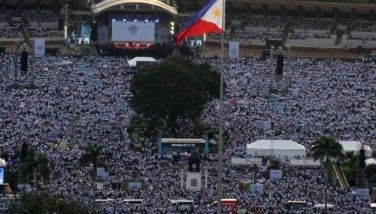Pasay dad stands by anti-fuel depot ordinance
May 27, 2002 | 12:00am
A Pasay City councilor stood by the council’s proposed ordinance banning the establishment of fuel depots in the city, despite airport officials’ lament that it would be a huge headache to the new Ninoy Aquino International Airport (NAIA) Terminal 3 project set to open in December.
"Certainly we know that the ordinance would affect NAIA 3, but it’s not our fault anymore. That’s what they get for bypassing us," said Councilor Alan Panaligan in a telephone interview Friday.
Panaligan said that aside from being relocated to the northeastern border of the NAIA compound, the fuel farm will be turned into a much bigger facility. At present, the fuel farm is said to have a total storage capacity of 30 million liters of high-octane aviation fuel. The ordinance prohibits existing gasoline stations, cooking gas refilling stations, and aviation fuel stations to increase their present stock of fuel.
As early as 1999, the city council had passed a resolution expressing "grave concern" about the environmental and sociological impact of transferring the fuel farm. The relocation project has been met with wide protests from Pasay residents as the proposed site is only 200-meters away from Barangay 201, a heavily populated area.
The fuel farm is managed by the country’s big three oil companies under the Joint Oil Companies Storage Project (JOCASP). The council’s Committee on Engineering and Public Works, headed by Panaligan, has recommended approval of the ordinance.
In an earlier interview, Edgardo Manda, Manila International Airport Authority (MIAA) general manager, hinted the ordinance is a big headache to the national government. Pipelines that will run from the fuel farm’s present location to the new terminal can be a temporary solution, Manda had said.
He added that a group of MIAA representatives are now discussing the matter with the Pasay City councilors but Panaligan said he was not aware of any talks.
Manda said the fuel farm is one of the most difficult facilities to construct for the Terminal 3 project, primarily because of the safety factor. This was also why, Manda said, MIAA has objected to a provision to the Philippine International Air Terminals Corp.’ s (PIATCO) proposed fourth supplement to the amended and revised concessionaire’s agreement which indicates a specific deadline for the fuel farm. PIATCO is the private operator of the NAIA 3.
"In the proposed fourth supplement, PIATCO sets the fuel farm deadline on the NAIA 3’s in-service date, which is Dec. 15. We don’t want a specific deadline because a fuel farm is very difficult to build," Manda said.
MIAA has also objected to the proposed expanded definition of the Government of the Republic of the Philippines (GRP), which Manda argued, has already been approved by the ICC-NEDA in the original contract between the national government and PIATCO. The fourth supplement, along with MIAA’s comments, has been with the DOTC for review for nearly a year, Manda said.
The national government could be fined heavily for any delays in its obligations in the NAIA 3 projects.
"Certainly we know that the ordinance would affect NAIA 3, but it’s not our fault anymore. That’s what they get for bypassing us," said Councilor Alan Panaligan in a telephone interview Friday.
Panaligan said that aside from being relocated to the northeastern border of the NAIA compound, the fuel farm will be turned into a much bigger facility. At present, the fuel farm is said to have a total storage capacity of 30 million liters of high-octane aviation fuel. The ordinance prohibits existing gasoline stations, cooking gas refilling stations, and aviation fuel stations to increase their present stock of fuel.
As early as 1999, the city council had passed a resolution expressing "grave concern" about the environmental and sociological impact of transferring the fuel farm. The relocation project has been met with wide protests from Pasay residents as the proposed site is only 200-meters away from Barangay 201, a heavily populated area.
The fuel farm is managed by the country’s big three oil companies under the Joint Oil Companies Storage Project (JOCASP). The council’s Committee on Engineering and Public Works, headed by Panaligan, has recommended approval of the ordinance.
In an earlier interview, Edgardo Manda, Manila International Airport Authority (MIAA) general manager, hinted the ordinance is a big headache to the national government. Pipelines that will run from the fuel farm’s present location to the new terminal can be a temporary solution, Manda had said.
He added that a group of MIAA representatives are now discussing the matter with the Pasay City councilors but Panaligan said he was not aware of any talks.
Manda said the fuel farm is one of the most difficult facilities to construct for the Terminal 3 project, primarily because of the safety factor. This was also why, Manda said, MIAA has objected to a provision to the Philippine International Air Terminals Corp.’ s (PIATCO) proposed fourth supplement to the amended and revised concessionaire’s agreement which indicates a specific deadline for the fuel farm. PIATCO is the private operator of the NAIA 3.
"In the proposed fourth supplement, PIATCO sets the fuel farm deadline on the NAIA 3’s in-service date, which is Dec. 15. We don’t want a specific deadline because a fuel farm is very difficult to build," Manda said.
MIAA has also objected to the proposed expanded definition of the Government of the Republic of the Philippines (GRP), which Manda argued, has already been approved by the ICC-NEDA in the original contract between the national government and PIATCO. The fourth supplement, along with MIAA’s comments, has been with the DOTC for review for nearly a year, Manda said.
The national government could be fined heavily for any delays in its obligations in the NAIA 3 projects.
BrandSpace Articles
<
>
- Latest
- Trending
Trending
Latest
Trending
Latest
Recommended



















